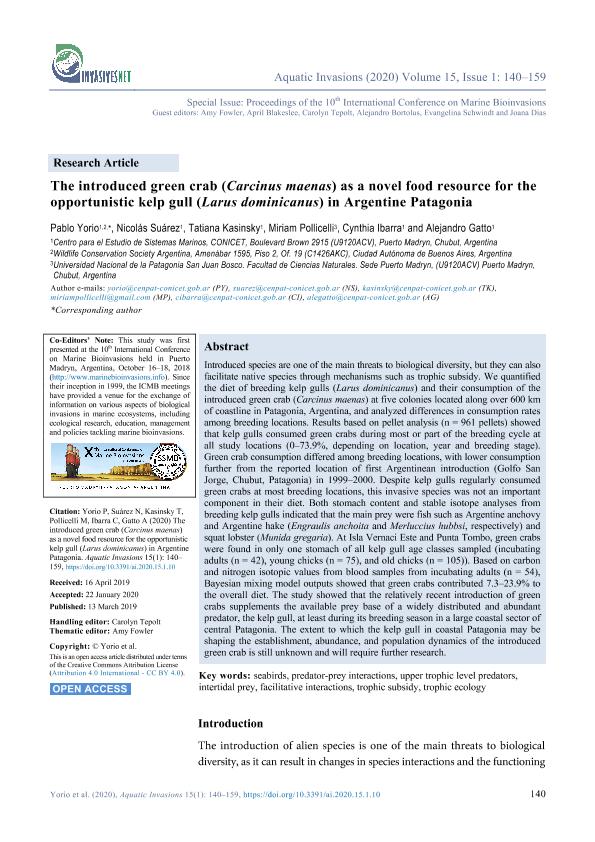Mostrar el registro sencillo del ítem
dc.contributor.author
Yorio, Pablo Martin

dc.contributor.author
Suarez, Nicolas Marcelo

dc.contributor.author
Kasinsky Aguilera, Lorna Tatiana

dc.contributor.author
Pollicelli, Miriam
dc.contributor.author
Ibarra, Cynthia

dc.contributor.author
Gatto, Alejandro Javier

dc.date.available
2021-08-12T13:56:58Z
dc.date.issued
2020-03
dc.identifier.citation
Yorio, Pablo Martin; Suarez, Nicolas Marcelo; Kasinsky Aguilera, Lorna Tatiana; Pollicelli, Miriam; Ibarra, Cynthia; et al.; The introduced green crab (Carcinus maenas) as a novel food resource for the opportunistic kelp gull (larus dominicanus) in argentine patagonia; Regional Euro-Asian Biological Invasions Centre; Aquatic Invasions; 15; 1; 3-2020; 140-159
dc.identifier.issn
1798-6540
dc.identifier.uri
http://hdl.handle.net/11336/138203
dc.description.abstract
Introduced species are one of the main threats to biological diversity, but they can also facilitate native species through mechanisms such as trophic subsidy. We quantified the diet of breeding kelp gulls (Larus dominicanus) and their consumption of the introduced green crab (Carcinus maenas) at five colonies located along over 600 km of coastline in Patagonia, Argentina, and analyzed differences in consumption rates among breeding locations. Results based on pellet analysis (n = 961 pellets) showed that kelp gulls consumed green crabs during most or part of the breeding cycle at all study locations (0–73.9%, depending on location, year and breeding stage). Green crab consumption differed among breeding locations, with lower consumption further from the reported location of first Argentinean introduction (Golfo San Jorge, Chubut, Patagonia) in 1999–2000. Despite kelp gulls regularly consumed green crabs at most breeding locations, this invasive species was not an important component in their diet. Both stomach content and stable isotope analyses from breeding kelp gulls indicated that the main prey were fish such as Argentine anchovy and Argentine hake (Engraulis anchoita and Merluccius hubbsi, respectively) and squat lobster (Munida gregaria). At Isla Vernaci Este and Punta Tombo, green crabs were found in only one stomach of all kelp gull age classes sampled (incubating adults (n = 42), young chicks (n = 75), and old chicks (n = 105)). Based on carbon and nitrogen isotopic values from blood samples from incubating adults (n = 54), Bayesian mixing model outputs showed that green crabs contributed 7.3–23.9% to the overall diet. The study showed that the relatively recent introduction of green crabs supplements the available prey base of a widely distributed and abundant predator, the kelp gull, at least during its breeding season in a large coastal sector of central Patagonia. The extent to which the kelp gull in coastal Patagonia may be shaping the establishment, abundance, and population dynamics of the introduced green crab is still unknown and will require further research.
dc.format
application/pdf
dc.language.iso
eng
dc.publisher
Regional Euro-Asian Biological Invasions Centre
dc.rights
info:eu-repo/semantics/openAccess
dc.rights.uri
https://creativecommons.org/licenses/by/2.5/ar/
dc.subject
FACILITATIVE INTERACTIONS
dc.subject
INTERTIDAL PREY
dc.subject
PREDATOR-PREY INTERACTIONS
dc.subject
SEABIRDS
dc.subject
TROPHIC ECOLOGY
dc.subject
TROPHIC SUBSIDY
dc.subject
UPPER TROPHIC LEVEL PREDATORS
dc.subject.classification
Ecología

dc.subject.classification
Ciencias Biológicas

dc.subject.classification
CIENCIAS NATURALES Y EXACTAS

dc.title
The introduced green crab (Carcinus maenas) as a novel food resource for the opportunistic kelp gull (larus dominicanus) in argentine patagonia
dc.type
info:eu-repo/semantics/article
dc.type
info:ar-repo/semantics/artículo
dc.type
info:eu-repo/semantics/publishedVersion
dc.date.updated
2021-04-28T21:00:45Z
dc.identifier.eissn
1818-5487
dc.journal.volume
15
dc.journal.number
1
dc.journal.pagination
140-159
dc.journal.pais
Finlandia

dc.description.fil
Fil: Yorio, Pablo Martin. Consejo Nacional de Investigaciones Científicas y Técnicas. Centro Científico Tecnológico Conicet - Centro Nacional Patagónico. Centro para el Estudio de Sistemas Marinos; Argentina. Wildlife Conservation Society; Estados Unidos
dc.description.fil
Fil: Suarez, Nicolas Marcelo. Consejo Nacional de Investigaciones Científicas y Técnicas. Centro Científico Tecnológico Conicet - Centro Nacional Patagónico. Centro para el Estudio de Sistemas Marinos; Argentina
dc.description.fil
Fil: Kasinsky Aguilera, Lorna Tatiana. Consejo Nacional de Investigaciones Científicas y Técnicas. Centro Científico Tecnológico Conicet - Centro Nacional Patagónico. Centro para el Estudio de Sistemas Marinos; Argentina
dc.description.fil
Fil: Pollicelli, Miriam. Universidad Nacional de la Patagonia "San Juan Bosco"; Argentina
dc.description.fil
Fil: Ibarra, Cynthia. Consejo Nacional de Investigaciones Científicas y Técnicas. Centro Científico Tecnológico Conicet - Centro Nacional Patagónico. Centro para el Estudio de Sistemas Marinos; Argentina
dc.description.fil
Fil: Gatto, Alejandro Javier. Consejo Nacional de Investigaciones Científicas y Técnicas. Centro Científico Tecnológico Conicet - Centro Nacional Patagónico. Centro para el Estudio de Sistemas Marinos; Argentina
dc.journal.title
Aquatic Invasions
dc.relation.alternativeid
info:eu-repo/semantics/altIdentifier/doi/http://dx.doi.org/10.3391/ai.2020.15.1.10
dc.relation.alternativeid
info:eu-repo/semantics/altIdentifier/url/https://www.reabic.net/aquaticinvasions/2020/issue1.aspx
Archivos asociados
